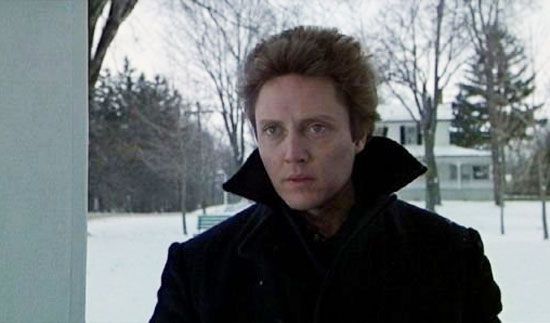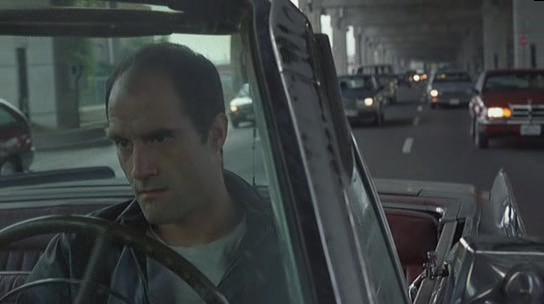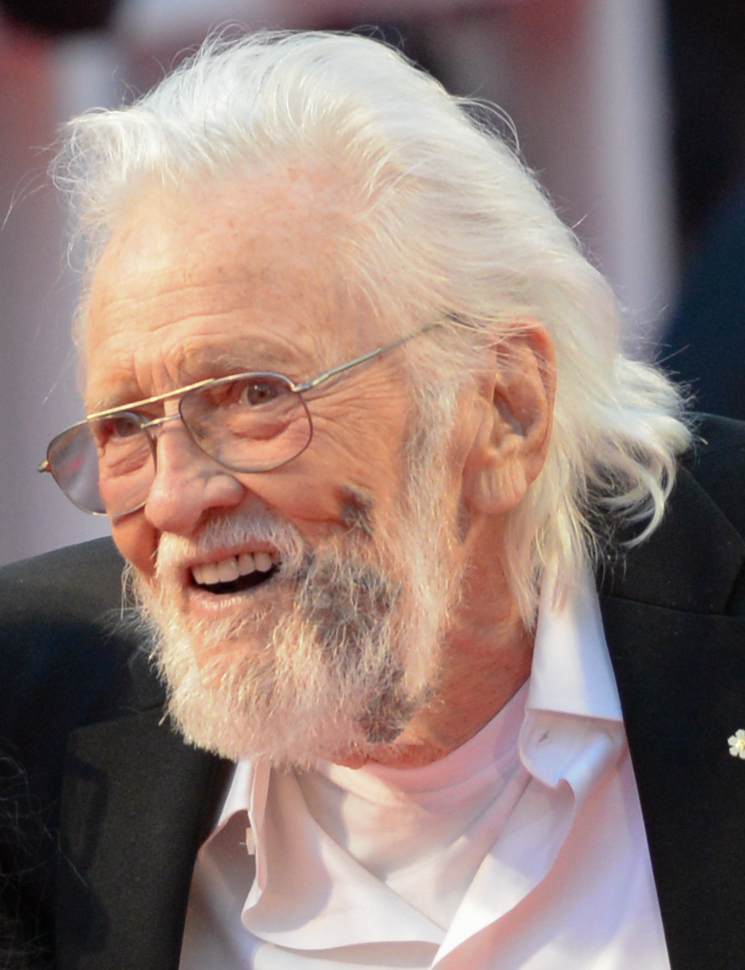
The world of rock and roll mourned on May 29, 2022, with the passing of Ronald Cornett Hawkins, affectionately known as “The Hawk,” at the age of 87. An American rock and roll singer who made Canada his home, Hawkins was a dynamic force, a keen talent scout, and a foundational figure in rock music across North America. His career, spanning over half a century, left an indelible mark, influencing generations of artists.
From his early days in Arkansas to becoming an institution in Ontario’s music scene, Hawkins embodied the raw energy and spirit of rockabilly. His stage antics were legendary, his covers iconic, and his knack for nurturing musical talent unparalleled. He performed across North America, recording more than 25 albums and leaving a resonant legacy in popular music history.
This retrospective delves into the initial chapters of Hawkins’ extraordinary journey, examining the crucial early experiences that shaped his unique sound and dynamic presence. We explore his formative years, the development of his iconic stage persona, and the strategic move to Canada that solidified his place as the “father of Canadian rock n’ roll,” alongside early successes and pivotal relationships.
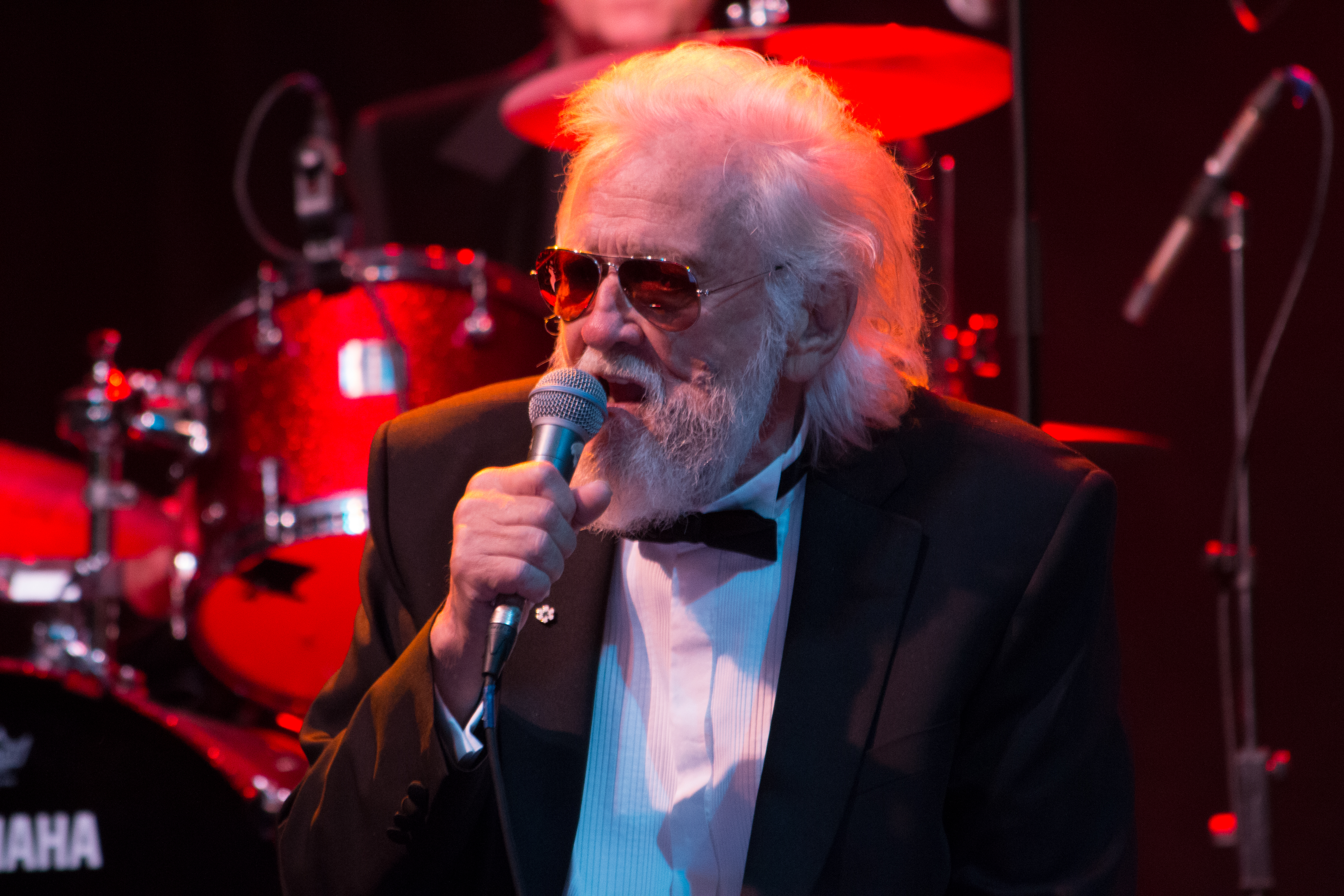
1. **Early Life and Musical Beginnings in Arkansas** Ronald Cornett Hawkins was born on January 10, 1935, in Huntsville, Arkansas. His family moved to Fayetteville in 1945, where Hawkins graduated from high school in 1952. Music was deeply ingrained; his father, uncles, and cousins had toured the honky-tonk circuit in Arkansas and Oklahoma in the 1930s and 1940s. His uncle, Delmar “Skipper” Hawkins, even joined Roy Rogers’s band, the Sons of the Pioneers, around 1940.
Ronnie Hawkins began singing at local fairs at age eleven. Before he was a teenager, he shared a stage with Hank Williams. Hawkins recalled Williams being too intoxicated to perform, prompting his band to invite audience members to sing. Hawkins seized the opportunity, performing Burl Ives songs, an early, unplanned entry into live performance that proved foundational.
As a teenager, Hawkins demonstrated an entrepreneurial spirit, running bootleg liquor from Missouri to Oklahoma’s dry counties. He claimed this activity funded his later investments in nightclubs. He formed his first band, The Hawks, upon graduating high school in 1952. He then briefly studied physical education at the University of Arkansas, leaving in 1956, just shy of graduation.
His brief six-month United States Army enlistment proved pivotal. At Fort Sill in Oklahoma, Hawkins encountered an African American quartet playing jazz/blues at the Amvets club. The music so moved him that he jumped on stage to sing. He described the sound as “something between the blues and rockabilly,” a fusion profoundly shaping his musical direction. This led him to form a new group with the four black musicians, renaming themselves the Blackhawks.
Hawkins sought to infuse contemporary influences into their repertoire. With blues saxophonist A.C. Reed, they created “some of the South’s most dynamic music sounds.” Hawkins stated, “instead of doing a kind of rockabilly that was closer to country music, I was doing rockabilly that was closer to soul music, which was exactly what I liked.” Despite facing prejudice, this period was crucial in defining his distinctive, soulful rockabilly style.
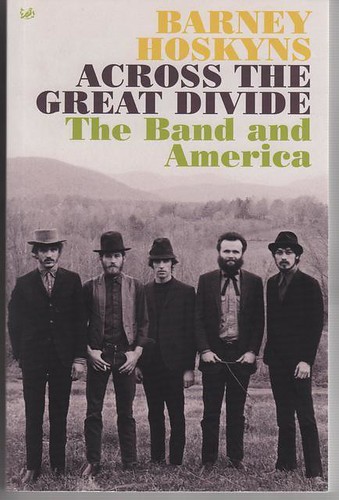
2. **The Formation of The Hawks and Levon Helm’s Entry** After his military enlistment ended, the Blackhawks disbanded, and Hawkins returned to Fayetteville. A call from Sun Records followed, inviting him to front their house session band, though the group had broken up by his arrival. Hawkins used the opportunity to cut two demos: Lloyd Price’s “Lawdy Miss Clawdy” and Hank Williams’s “A Mansion on the Hill.” These initial recordings, however, attracted no immediate attention.
Demo session guitarist Jimmy Ray “Luke” Paulman suggested Hawkins join him in Helena, Arkansas, a vibrant hub of blues, rhythm and blues, and country music. Hawkins eagerly accepted. In Helena, Hawkins and Paulman quickly brought together Paulman’s brother George on standup bass and their cousin Willard “Pop” Jones on piano, forming a new band, The Hawks.
The introduction to drummer Levon Helm, from nearby Turkey Scratch, Arkansas, occurred in early 1957. George Paulman invited Helm to sit in with The Hawks for their closing set at the Delta Supper Club. Helm vividly recalled Hawkins’s dramatic arrival at his family’s cotton farm in a Model A. Hawkins, described as “a big ol’ boy in tight pants, sharp shoes and a pompadour,” negotiated with Helm’s parents.
Helm’s parents insisted he graduate high school before joining The Hawks and traveling to Canada. Helm practiced diligently on a makeshift drum kit, honing his skills. By his graduation in May, he was proficient enough to officially join the band. This pivotal addition solidified a lineup that would soon achieve considerable renown, marking a significant moment in Hawkins’s career.
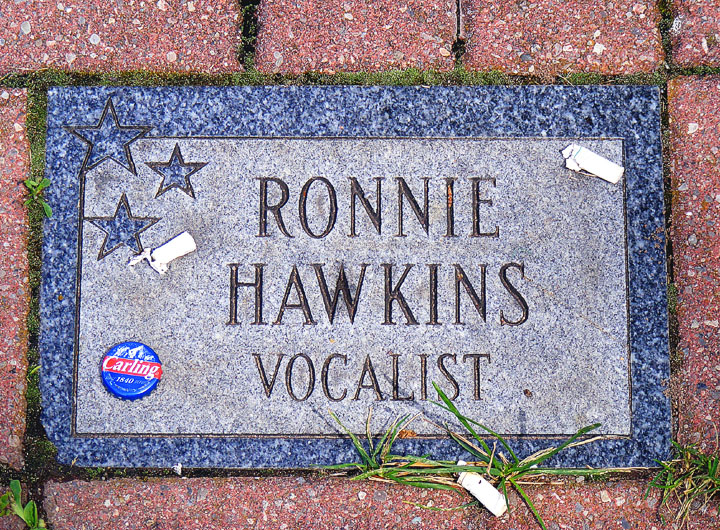
3. **Stage Persona: “Rockin’ Ronnie,” “Rompin Ronnie,” “Mr. Dynamo,” and the “Camel Walk”** Ronnie Hawkins was a consummate showman; his live performances were as legendary as his music. His stage act featured daring back flips and a signature move, the “camel walk,” a forward slide with bent knees. This unique dance predated Michael Jackson’s moonwalk by three decades, showcasing Hawkins’s pioneering approach to performance and establishing him as a visual innovator.
His dynamic presence and captivating antics earned him several memorable monikers from fans and the press, including “Rockin’ Ronnie,” “Rompin Ronnie,” and “Mr. Dynamo.” These nicknames perfectly captured the explosive energy he brought to every stage, making each performance an unforgettable experience. Hawkins understood that rock and roll required both powerful vocals and compelling visual theatrics, a lesson he imparted to many.
Beyond his own performances, Hawkins fostered the burgeoning rock and roll scene in Fayetteville. He owned and operated the Rockwood Club, which became a magnet for early rock and roll pioneers. Legends such as Jerry Lee Lewis, Carl Perkins, Roy Orbison, and Conway Twitty all graced its stage. This ownership demonstrated his commitment to the genre, providing a vital platform for talent.
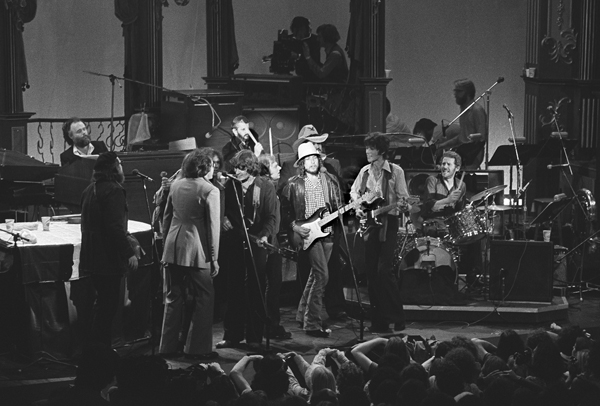
4. **The Move to Canada and Early Recording Success** In 1958, Ronnie Hawkins and his group began touring Canada as the Ron Hawkins Quartet, a move recommended by Conway Twitty. Twitty noted Canadian audiences’ receptiveness to rockabilly. Before their first Canadian excursion, bassist George Paulman was left behind due to substance abuse, leading the band to perform without a bass on their initial Ontario tour, a testament to their adaptability.
Their debut Canadian gig at the Golden Rail Tavern in Hamilton, Ontario, became instantly legendary. Booking agent Harold Kudlets noted that the band’s powerful sound and Hawkins’s audacious stage stunts were so overwhelming that “all the bartenders quit.” This anecdote vividly illustrates Hawkins’s visceral impact, signaling the beginning of his profound connection with Canadian musical culture.
The year 1959 was a landmark for Hawkins. He performed numerous live shows, solidifying his reputation, and crucially, signed a five-year contract with Roulette Records. Working primarily out of Toronto, Ronnie Hawkins and The Hawks released their debut LP, *Ronnie Hawkins*, in 1959. This album showcased their distinctive rockabilly sound and marked their official entry into the recording industry.
The following year, with Fred Carter, Jr. replacing Jimmy Ray “Luke” Paulman on lead guitar, the band recorded *Mr. Dynamo*, also on Roulette. These early recordings established The Hawks’ unique blend of blues, country, and rockabilly, defined by Hawkins’s powerful vocals and energetic instrumentation. Their first single, “Forty Days,” a reinterpretation of Chuck Berry’s “Thirty Days” with “Mary Lou” on the B-side, reached number 26 on the U.S. pop charts, becoming Hawkins’s biggest hit.
Read more about: More Than Just a Chassis: Uncovering 11 Catastrophic Design Flaws That Defined Automotive Infamy
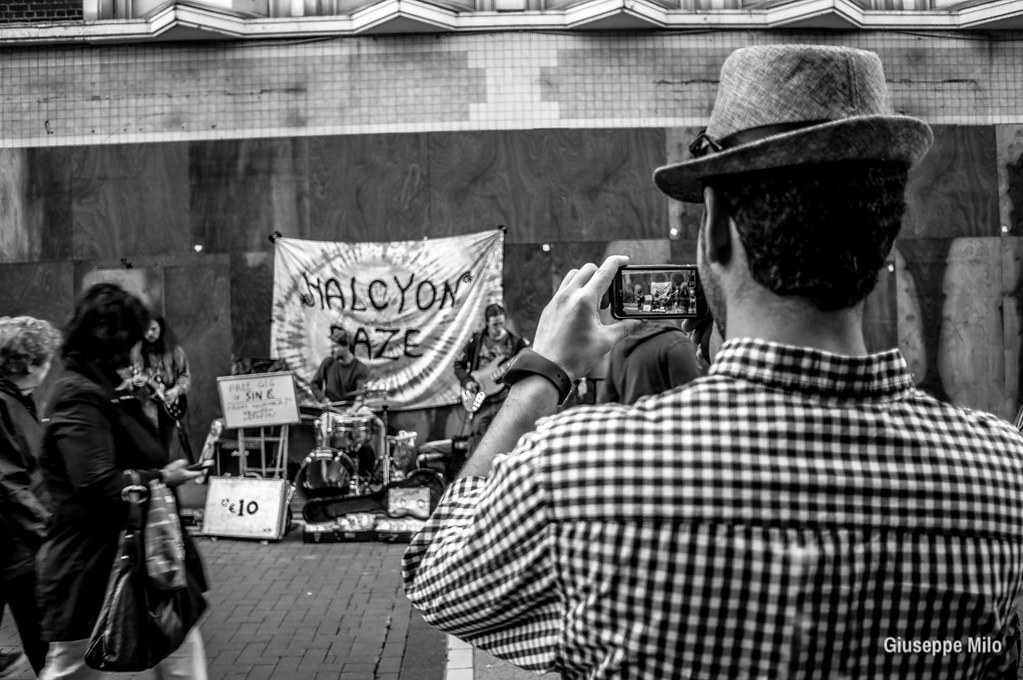
5. **The Toronto Scene and the New Hawks Lineup** Ronnie Hawkins’s affinity for Canada grew, leading him to become a permanent resident in 1964. He initially based himself in Ontario, playing venues like the Grange Tavern in Hamilton. It was in Toronto, however, that Hawkins truly made his mark, with The Hawks dominating the local music scene. He further cemented his presence by opening his own nightclub, the Hawk’s Nest, on the second floor of Le Coq d’Or Tavern on Yonge Street.
The Hawk’s Nest became a regular haunt where he and his band performed for months, cultivating a dedicated following. This period also saw a significant change in the band’s personnel. With the exception of drummer Levon Helm, the original Hawks departed. This created an opportunity for new talent to emerge: Robbie Robertson, Rick Danko, Richard Manuel, and Garth Hudson, all Southwest Ontarians.
This new lineup would achieve extraordinary international fame as The Band. Their transformation was a testament to Hawkins’s discerning eye for talent. David Clayton-Thomas, future lead vocalist of Blood, Sweat & Tears, vividly recalled The Hawks’ profound impact, stating he would “sit there by the bar at Le Coq d’Or and just hang on every note.”
This iteration of The Hawks, with their sharp mohair suits and razor-cut hair, became the preeminent group at Le Coq d’Or, a notorious yet vibrant establishment on Toronto’s Yonge Street strip. Despite frequent bar fights, The Hawks maintained remarkable professionalism, cementing their fixture in Toronto’s burgeoning music scene. This highlights Hawkins’s role as a crucial incubator for future stars.

6. **Robbie Robertson’s Introduction and Early Contributions** Robbie Robertson, the legendary guitarist, recounted his first encounter with Ronnie Hawkins and The Hawks in his 2016 memoir, *Testimony*. At fifteen, Robertson’s band, The Suedes, opened for The Hawks at Toronto’s Dixie Arena. The experience left an indelible mark as he witnessed Hawkins’s mesmerizing stage antics: spinning, flipping, and his iconic camel walk while Jimmy Ray “Luke” Paulman soloed. Robertson described Hawkins tumbling and landing at Paulman’s feet, a dynamic visual spectacle.
Robertson characterized the show as “the most violent, dynamic, primitive rock ‘n’ roll I had ever witnessed, and it was addictive.” This powerful introduction cemented his fascination. He also vividly recalled seeing Levon Helm for the first time, describing him as a “young beam of light on drums” at the core of this explosive musical whirlwind. The raw energy and masterful musicianship profoundly impacted Robertson’s perception of rock and roll.
With The Hawks scheduled for more performances at Le Coq d’Or, Robertson remained in their orbit, eager to absorb their Southern “mojo.” He overheard Hawkins needing new material for an upcoming studio session. Seizing this opportunity, Robertson stayed up all night, composing “Someone Like You” and “Hey Boba Lu.”
The next day, Robertson presented his compositions to Hawkins, who was impressed by the young guitarist’s initiative and talent. Hawkins recorded both for his album, *Mr. Dynamo*. This early collaboration provided Robertson with invaluable exposure and a significant break, illustrating Hawkins’s openness to new talent and his keen ear for songwriting, foreshadowing their creative partnership.
A year later, in 1960, Robertson pawned his 1957 Fender Stratocaster for a bus ticket to Fayetteville, Arkansas, to audition for The Hawks, “the most wicked rock ‘n’ roll band around.” Levon Helm met him, immersing him in the Deep South’s customs. Robertson, hoping to replace Fred Carter, Jr., spent formative time at the Helm family farm in Helena, Mississippi Delta. This immersion, coupled with rigorous musical training, was his “rockabilly boot camp,” shaping his guitar style and understanding of American roots music. While awaiting Hawkins’s and Helm’s return from England, Robertson practiced at the Rainbow Inn, buying stacks of records by Ray Charles and blues legends in Memphis, profoundly expanding his musical vocabulary. This rich exposure, fused with “rockabilly boot camp,” influenced his lead guitar work on the *Mojo Man* album recorded in 1961, where Chicago bluesmen’s influences became evident.

7. **Mentorship Beyond The Band: Nurturing New Generations**Ronnie Hawkins’s profound influence extended far beyond The Hawks, establishing him as an astute talent scout and crucial mentor. While the departure of members who formed The Band in 1964 was a significant turning point, it also provided new opportunities for Hawkins to cultivate emerging musicians. The split, though involving creative and financial differences, instilled in these artists an invaluable “rockabilly boot camp” experience, deepening their understanding of American roots music and showmanship.
Beyond The Band, Hawkins’s keen eye shaped numerous careers. Early Hawks guitarist Roy Buchanan, for instance, contributed to tracks like “Who Do You Love?” before his legendary solo career. Robbie Lane and the Disciples gained recognition opening for The Hawks in Toronto, eventually becoming Hawkins’s backing band. This continuous cycle of development provided a vital platform for groups to hone their skills, demonstrating his enduring commitment to the musical ecosystem. Other musicians he recruited later formed groups such as Janis Joplin’s Full Tilt Boogie Band, Crowbar, Bearfoot, and Skylark, spreading his distinctive musical blend.
A compelling illustration of this mentorship unfolded in the early 1970s with guitarist Pat Travers. Impressed by Travers’s skill, Hawkins invited him to join. Travers initially hesitated at Hawkins’s insistence on meticulously replicating “old ’50s and ’60s rockabilly tunes.” Hawkins, however, sagely advised that mastering these fundamentals would make him “better than a hundred guitar players.” This formative experience proved crucial for Travers, who achieved a successful career in 1970s hard rock, a testament to Hawkins’s profound foresight.
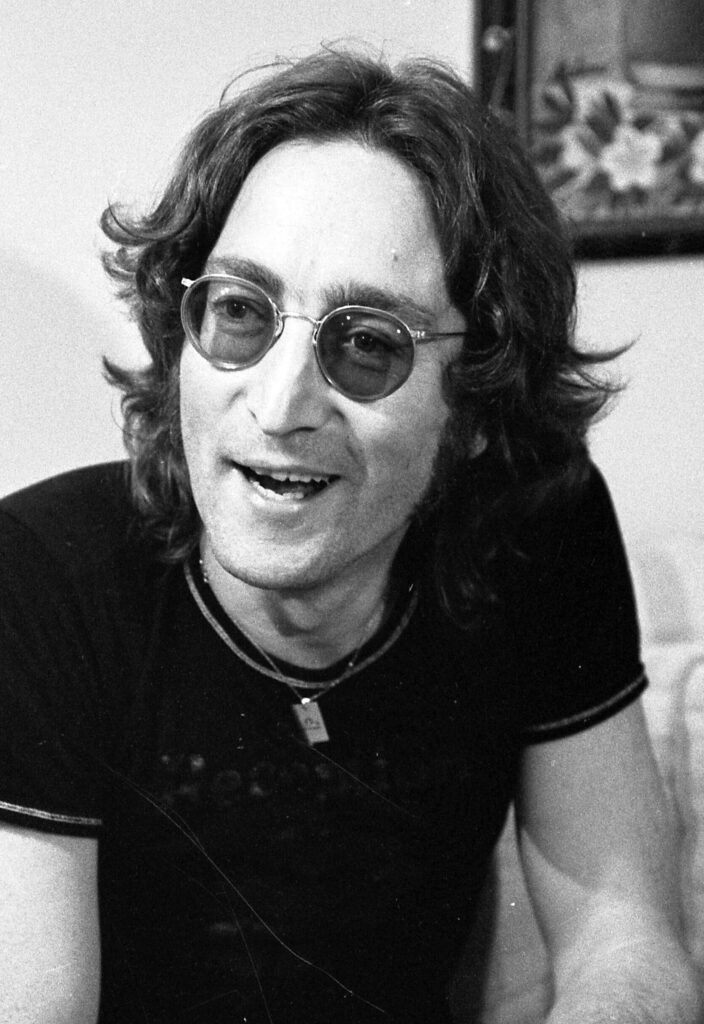
8. **Collaborations with Legends: From Lennon to Allman**Ronnie Hawkins’s charisma attracted some of music’s most iconic figures, fostering notable collaborations and enduring friendships that transcended genres. These interactions underscored his unique position as a respected peer and generous host, solidifying his status as a cultural nexus in Canada.
One celebrated instance occurred in December 1969 when Hawkins hosted John Lennon and Yoko Ono at his Mississauga home. Engaged in their peace campaign, the legendary couple found a sympathetic ally. During their stay, Lennon signed “Bag One” lithographs and recorded a radio promo for Hawkins’s single, “Down in the Alley,” lending formidable support. Hawkins’s involvement extended to joining Lennon and Ono to meet Prime Minister Pierre Trudeau, and Lennon even enlisted him as a “peace ambassador” to the China-Hong Kong border.
A different, yet equally significant, musical collaboration unfolded in 1970 at FAME Studios in Muscle Shoals, Alabama. These sessions, for an unproduced album, featured Duane Allman as a studio musician. Allman’s distinctive backing guitar on tracks like Carl Perkins’s “Matchbox” and Don Gibson’s “Don’t Tell Me Your Troubles” later appeared on *Duane Allman An Anthology Volume II*. Four additional tracks were included on *Skydog*, a 2016 Allman retrospective, confirming the enduring quality of Hawkins’s material and the high caliber of musicianship he consistently attracted.
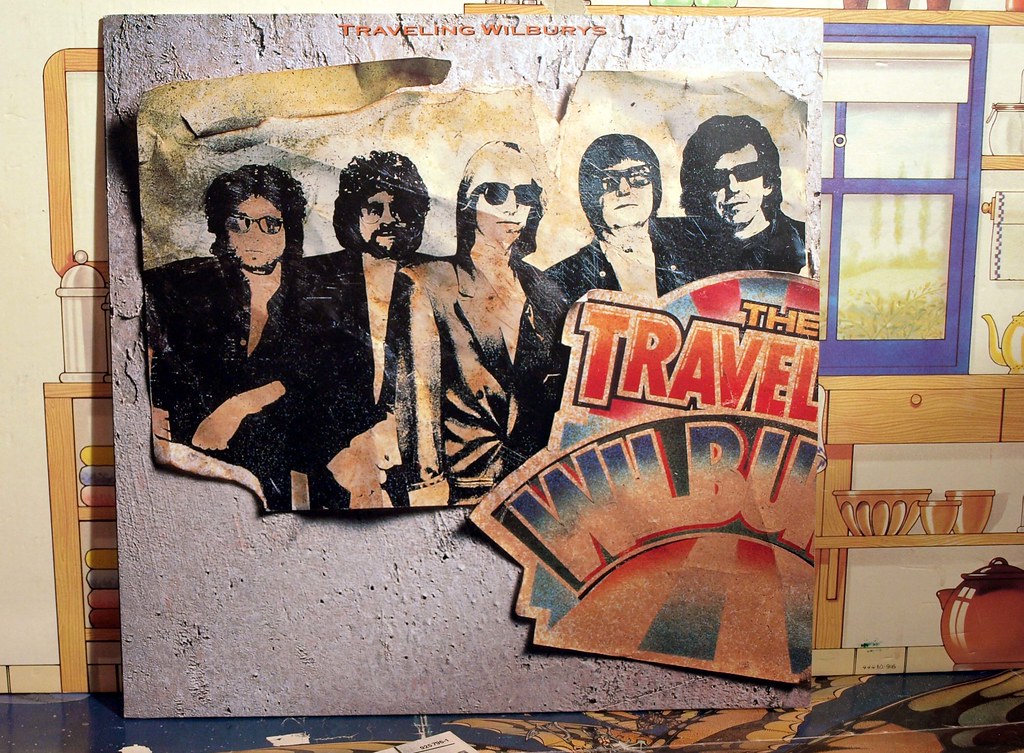
9. **A Cinematic Presence: Hawkins on Screen**Beyond the stage, Ronnie Hawkins carved a unique presence in film and television, showcasing a natural theatricality complementing his music. His larger-than-life persona, with engaging storytelling and undeniable charm, translated effectively to visual media, solidifying his status as a multifaceted entertainer.
A particularly intriguing cinematic role came in 1975 when Bob Dylan cast Hawkins to portray “Bob Dylan” in his experimental film, *Renaldo and Clara*. This unconventional choice highlights the mutual respect between artists, with Hawkins interpreting a fictionalized peer. His acting career also extended to mainstream cinema, including Michael Cimino’s epic Western *Heaven’s Gate* (1980) and the action/adventure film *Snake Eater*, diversifying his portfolio.
He embraced television, hosting his own show, *Honky Tonk*, in the early 1980s, providing a platform for his musical style and engaging personality. His distinctive “Mary Lou” was famously used in the 1989 slasher film, *Hello Mary Lou: Prom Night II*. Furthermore, his life was chronicled in the 1982 television documentary *The Hawk*, directed by Martin Kahan, offering an in-depth look at his contributions and enduring legacy.
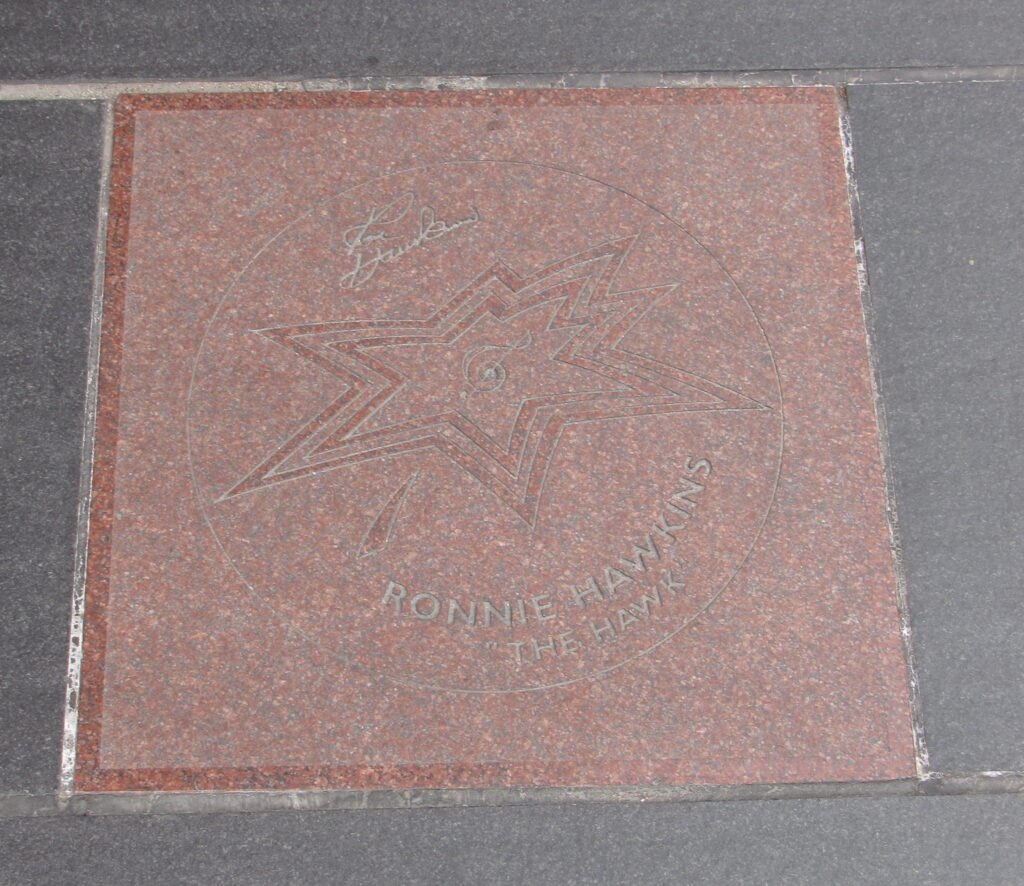
10. **The Last Waltz and Milestone Celebrations**Ronnie Hawkins’s journey was punctuated by significant milestone events, including his participation in The Band’s farewell concert and a grand celebration of his own career. These occasions served as powerful affirmations of his lasting impact and the respect he commanded, bringing together generations of talent to honor “The Hawk.”
A particularly poignant moment occurred in 1976 when he was a featured performer at The Band’s Thanksgiving Day farewell concert in San Francisco, immortalized in Martin Scorsese’s 1978 film, *The Last Waltz*. His presence underscored his foundational role in their development. Robbie Robertson light-heartedly recalled Hawkins’s characteristic wit regarding backstage substances, with Hawkins famously declaring attendees would be “sneezing biscuits” for months afterward due to their poor quality.
Nearly two decades later, on January 10, 1995, Ronnie Hawkins marked his 60th birthday with a spectacular concert at Massey Hall in Toronto, documented on the album *Let It Rock*. This star-studded celebration drew an impressive roster of rock and roll royalty, including Hawkins, Carl Perkins, Jerry Lee Lewis, and The Band. Canadian talents like Larry Gowan and Jeff Healey also joined, illustrating the cross-generational appeal Hawkins commanded. The ensemble was collectively dubbed “the Rock ‘n’ Roll Orchestra,” fittingly capturing the magnitude of talent honoring “The Hawk.”

11. **Awards and Accolades: A Legacy Recognized**Ronnie Hawkins’s profound contributions earned him a significant array of awards and accolades throughout his career, spanning national recognition, industry commendations, and academic distinctions. These celebrated his pioneering spirit, mentorship, and unwavering commitment to music and charitable causes, testament to his indelible impact across North America, particularly in Canadian music.
One early recognition came in 1984: his LP, *Making It Again*, garnered a Juno Award for Best Country Male Vocalist. His consistent quality was further recognized with the Walt Grealis Special Achievement Award at the 1996 Juno Awards. In 2007, he received a Special Achievement Award from SOCAN, underscoring his creative contributions. His pivotal role in Canadian music was formally enshrined on October 4, 2002, declared “Ronnie Hawkins Day” by Toronto, and he was inducted into Canada’s Walk of Fame, acknowledging his lifetime contribution and generous charitable support.
Further institutional recognition followed: on March 4, 2004, Hawkins was inducted into the Canadian Music Industry Hall of Fame. His pioneering rockabilly contribution was also formally acknowledged by the Rockabilly Hall of Fame. In 2005, Laurentian University bestowed an honorary degree. Perhaps the highest honor came on May 2, 2013, when he was named an Honorary Officer of the Order of Canada, with investiture on May 7, 2014. The citation lauded his role as the “father of Canadian rock n’ roll” and his support for charitable causes, capturing the essence of his extraordinary life.
Read more about: The 1982 ‘Annie’ Film: A Comprehensive Retrospective on its Production, Mixed Reception, and Lasting Cultural Imprint

12. **Later Life, Resilience, and Enduring Spirit**Even in his later years, Ronnie Hawkins remained an active and vibrant force in music, embodying remarkable resilience and an enduring spirit that captivated audiences. His dedication to performing, coupled with characteristic wit and optimism, underscored his genuine passion for his craft, proving age was merely a number for his magnetic stage presence.
Hawkins remarkably played “150 engagements a year” in his 60s, a testament to his stamina and unwavering commitment to live performance. This tireless schedule showcased his deep connection with fans. His later life, however, included a significant health battle in 2002 with pancreatic cancer. In a story capturing public imagination, his cancer went into remission, a recovery he attributed to a “miracle” by “the ‘Big Rocker’ and Adam ‘Dreamhealer’ McLeod,” a 16-year-old healer. This remarkable remission became the subject of the 2012 film *Ronnie Hawkins: Still Alive and Kicking*, solidifying his image as a survivor.
In 2017, Hawkins moved from Stoney Lake Manor, his residence since 1970, to Peterborough, Ontario, marking a new personal chapter. Ronnie Hawkins passed away on May 29, 2022, at 87, his family stating he had been ill. His death marked the end of an era, leaving a legacy of music, mentorship, and unforgettable performances. He is survived by his wife of 60 years, Wanda, their sons Ronnie Jr. and Robin Hawkins, daughter Leah Hawkins, and four grandchildren. “The Hawk” truly lived a life embodying rock and roll’s vibrant and enduring spirit.
Read more about: Jack Betts Remembered: A Six-Decade Odyssey Through Broadway, Spaghetti Westerns, and Iconic Hollywood Roles
Ronnie Hawkins’s journey, from the honky-tonks of Arkansas to becoming the undisputed “father of Canadian rock n’ roll,” is a powerful narrative of passion, perseverance, and profound influence. He was more than a performer; he was a cultural architect, building bridges between genres and generations, fostering talent with a keen eye and a generous spirit. His stage antics were legendary, his music timeless, and his impact on the careers of countless musicians immeasurable. As we reflect on the life of “The Hawk,” it becomes clear that his roar will echo in the annals of music history, a vibrant testament to a life lived fully in the rhythm and soul of rock and roll.



